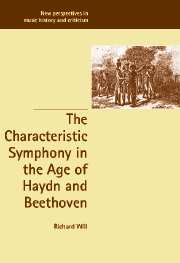Book contents
- Frontmatter
- Contents
- Acknowledgments
- Note to the reader
- Introduction
- 1 Paradise lost: Dittersdorf's Four Ages of the World and the crisis of Austrian enlightened despotism
- 2 Preaching without words: Reform Catholicism versus divine mystery in Haydn's Seven Last Words
- 3 The boundaries of the art: characteristic music in contemporary criticism and aesthetics
- 4 Paradise regained: time, morality, and humanity in Beethoven's Pastoral Symphony
- 5 Making memories: symphonies of war, death, and celebration
- Appendixes
- Bibliography
- Index
Introduction
Published online by Cambridge University Press: 11 January 2010
- Frontmatter
- Contents
- Acknowledgments
- Note to the reader
- Introduction
- 1 Paradise lost: Dittersdorf's Four Ages of the World and the crisis of Austrian enlightened despotism
- 2 Preaching without words: Reform Catholicism versus divine mystery in Haydn's Seven Last Words
- 3 The boundaries of the art: characteristic music in contemporary criticism and aesthetics
- 4 Paradise regained: time, morality, and humanity in Beethoven's Pastoral Symphony
- 5 Making memories: symphonies of war, death, and celebration
- Appendixes
- Bibliography
- Index
Summary
“Characteristic” is the most common of several terms used in the eighteenth and early nineteenth centuries to indicate instrumental music in which a subject is specified, usually by a text. Over 225 orchestral works qualify, some with sentences and paragraphs describing each of several movements, or what modern listeners would call a program, and others with only a word or two characterizing a single movement or a whole work (see Appendixes 1 and 2, pp. 249–98 below). They are “symphonies” according to the way in which the word was used at the time, to encompass orchestral pieces of many shapes and sizes rather than solely the three- and four-movement examples that match later conceptions of the genre. The disparity in their texts reflects varying compositional ambitions as well as chronological development, the more elaborate characterizations appearing mostly after 1770 and then with increasing frequency as the years pass.
But however long their texts and whatever their length or structure, symphonies bearing written characterizations in the years 1750–1815 are drawn together by a marked affinity for a few common subjects. Titles consisting of only one or a few words identify over 70 examples as pastoral (Appendix 2), 15 as military, 15 as hunts, 10 as storms, and more than 30 as expressions of national or regional characters – in sum, nearly 150 symphonies or movements as representations of five subject categories (Appendix 3a–d).
- Type
- Chapter
- Information
- Publisher: Cambridge University PressPrint publication year: 2002



